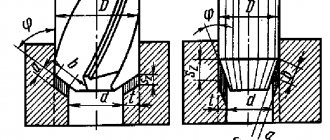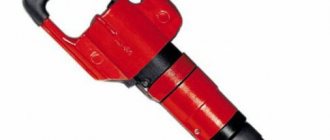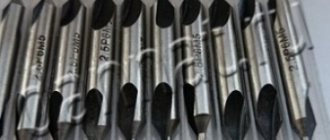Countersink
What is the difference between countersinking and countersinking? Although they sound similar, they are different operations. Each has its own purpose and a specific tool for execution.
What is countersinking? It involves cutting off a larger layer of material in order to create a conical or cylindrical recess in the upper part of the hole, intended for hidden installation of fasteners. Countersinking is also used to select chamfers. A special device for performing this operation is called a countersink. The following types are distinguished:
- cylindrical, used to make cylindrical recesses at the top of the hole to hide the heads of screws or nuts;
- conical, with their help they cut out a cone-shaped recess in the lower part of the hole, chamfer and form recesses for fasteners.
- end, also called counterbore, such a tool is needed for cleaning out recesses before installing fasteners.
Structurally, the countersink consists of two parts: the working head and the shank. A guide pin is provided on the shank, ensuring alignment of the selected recesses.
A drilling machine is usually used as equipment along with countersinks. Less commonly, they are clamped into the chuck of a multi-axis machining center or a simple lathe. Drills and other hand-held drilling tools are not recommended for use as they cannot provide proper alignment and accuracy.
Countersinking is the processing of the inner surface of a hole to improve its quality.
- accuracy;
- roughness;
- forms.
Countersinking is used to process holes made by drilling, stamping or casting. A countersink is used to perform the operation. It resembles a drill, but differs from it in the following ways:
- a large number of cutting edges;
- thickened bridge between edges;
- beveled corner.
These design features determine the stability of the position of the countersink relative to the hole and their coaxiality. The countersink does not deepen the hole, but only improves the smoothness and shape of the surface, removing a very thin layer of material.
Countersinks have from six to eight cutting edges; small diameter tools (up to 20 mm) are made in one piece, while larger ones have inserted blades.
Follow the rules when working with a counterbore
When performing counterboring, you must adhere to a number of rules:
- When counterboring open surfaces, it is recommended to fix a stop on the tool shank. The simplest method is to use a thrust nut with a lock nut.
- When counterboring recesses for hardware heads, a tool with a vertex angle of 90° is used. Reducing the angle is carried out in cases where, after counterboring, a cut remains on the surface of the hole being machined.
- Making holes for hardware is carried out in two stages. First, a hole is drilled to a certain diameter, then the hole is given the desired shape and size by counterbore.
- The counterbore guide should not be in full contact with the bushing. Contact with screw strips is acceptable. Violation of this rule can lead to jamming of the counterbore in the bushing as a result of strong heating of the workpiece and metal-cutting tool under the influence of high rotation speed of the machine spindle.
- Hole alignment is ensured through the use of counterbores with guides.
- When securing an end countersink in a quick-change chuck, it is recommended to place the cutting teeth at both ends.
- To process workpieces made of high-hard metals, you should use tools with carbide inserts.
- For processing brittle alloys, it is recommended to use single-tooth screw end countersinks with a radially located front surface.
Compliance with the rules guarantees perfectly accurate sized holes.
Types and application of countersinks
Depending on the purpose, countersinks are divided into the following types:
- for making conical or cylindrical recesses inside holes;
- to create reference planes rippled with a hole;
- for chamfering;
- to prepare holes for installation of fasteners.
Based on the shape of the working surface there are:
- cylindrical;
- conical;
- end or straight.
Depending on the diameter, countersinks are divided into:
- regular (0.5 ÷ 1.5 mm);
- with limiter cone (0.5 ÷6 mm);
- with a cone-shaped shank (8÷12 mm).
For the reaming operation, a combined device is used, which includes a drill, a reamer, a countersink and a countersink. They are mounted on a common shank, and the working surfaces are spaced apart in height and come into contact with the metal in turn, as the tool is immersed in the material. The use of such a combined tool allows you to drill a hole, make chamfers, and improve the quality of the surface in one technological pass. This saves a lot of time on changing tools and ensures the accuracy of the dimensions of each structural element. Such a device is expensive and is assembled anew for each hole size, so its use is economically justified only for mass production or for a product with a large number of identical holes of a complex configuration.
What is a countersink, systematization
A cutting tool for metal (countersink) allows you to countersink an opening in a part up to accuracy group 5. It is widely used for semi-finishing parts before mechanical reaming. According to its structure, it is divided into types:
- holistic;
- nozzles;
- tail;
- connected.
Externally, metal-cutting devices look like a simple small drill, but have an increased number of cutting edges. The correct dimensions of the opening of the workpiece being processed is determined by the gauge. The tools are fastened in the unit's chuck with the support of the shank.
To cultivate openings with a diameter of up to 10 cm, attachments with 4 points are used. Their main feature is fastening through a mandrel. The presence of a chamfer on the teeth of the element made it possible to achieve correct adjustment of the cut.
Design
The conical countersink has two main structural parts:
- a shank designed for attaching a countersink to the chuck of a drilling or lathe;
- a working body for countersinking holes, consisting of 6 ÷ 12 cutting edges of increased thickness (compared to a drill.
The cone sweep angle is from 60 to 120°. The number of edges depends on the diameter of the tool; the larger it is, the more edges there are.
A cylindrical countersink is structurally similar to a drill, but has a larger number of cutting edges. Their length, unlike a drill, is limited by the diameter of the cylinder, since the countersink makes only small recesses in depth.
At the end there is a guide pin that ensures fastening in the chuck. A removable belt can be installed behind the ends of the cutting edges, limiting the depth of immersion into the workpiece. The limiter can be designed as a non-removable part of the countersink. If necessary, a cutting attachment is mounted on the countersink. When depicting a hole in a drawing, the type and size of the countersink is indicated next to it or in an explanatory note in the margin.
For the manufacture of countersinks, high-quality steels are used: tool, high-speed, carbon. The tool is subjected to multi-stage heat treatment, which improves its strength properties.
Rules for using the tool
When using a countersink, work should be carried out using a lathe or drilling machine. It is very important that the chuck is in good condition, otherwise, when the cutter runs out, it will not be possible to obtain a clear cylindrical recess. The rules for using the tool are as follows:
- For each type of work, you need to choose the type of cutting element suitable for this purpose: to form a cone with a recess - a countersink with an oblong body and a guide pin, for small recesses - a regular conical countersink, for hard alloys - a tool with carbide tips.
- The diameter of the cutting element must correspond to the required diameter of the recess. If you machine with a tool with a much larger diameter, this can lead to poor centering of the recess relative to the hole, non-compliance with the cone angle and the exact depth.
- When choosing the rotation speed of the cutter, you must adhere to those speeds that are recommended for this particular tool. Excessive speed leads to overheating of the working part and rapid wear of the cutting edges.
- When working with cast iron or alloys made of solid material, it is necessary to remove heat from the working area; for this, special emulsions must be used.
- The countersink must be precisely centered relative to the middle of the hole.
Features of countersinking holes
Countersinking holes is a high-precision operation that requires high-quality tools and proper drilling equipment. Countersinks must undergo periodic inspection to ensure compliance with the standard for diameter and taper angle. The test results are recorded in the instrumental section log.
Metalworking specialists have formulated the following recommendations for performing the operation:
- when working with hard steel or cast iron alloys, special emulsions, for example, coolant liquid, should be used to cool the material and tool;
- when selecting a tool, you need to take into account the material of the part, its strength and hardness;
- Before starting work, you should check the reliability and accuracy of fixation of the tool in the chuck and the absence of any special spindle runout;
- to countersink an internal chamfer, you should use a special mandrel that centers the tool;
The countersunk hole should be checked for compliance with the dimensions of the drawing only with a verified measuring tool.
Basic rules for countersinking processing
Correct countersinking processing requires adherence to a specific technological process, which is developed for a specific part. The technological process itself is built on principles or rules that take into account absolutely any initial conditions: type of metal, hole diameter, shape, configuration, channel length, final countersinking task, type of tool.
The basic rules for processing with a countersink are as follows:
- After casting, stamping or drilling process, the allowance on the side in the hole for countersinking should be 0.5–3 millimeters.
- The type of cutting element must match the type of hole. They can be through, stepped or blind.
- The rotation speed when processing a cutter made of high-speed steel should not differ from the rotation speed of a conventional metal drill.
- The rotation speed of a cutter with carbide cutting edges can be increased two or three times compared to the rotation speed of a conventional countersink.
- For high precision machining of holes produced by casting or stamping, having a deep channel, they are first passed with a cutter to the depth of half the working fluid of the countersink and with a diameter equal to the diameter of the cutting edge.
When using countersinks made of high-speed steel, a substance is supplied into the channel being processed for lubrication and cooling.
Current GOST
Currently, state standard 14953-80 continues to apply. It regulates the technical conditions for countersinking, standard dimensions of the tool, and the material for its manufacture. The standard also describes the operating modes of the equipment depending on the mechanical characteristics of the material being processed.
Download GOST 14953-80
Tables for selecting standard countersinks serve as an aid for designers and technologists in determining design parameters and developing technical processes.











